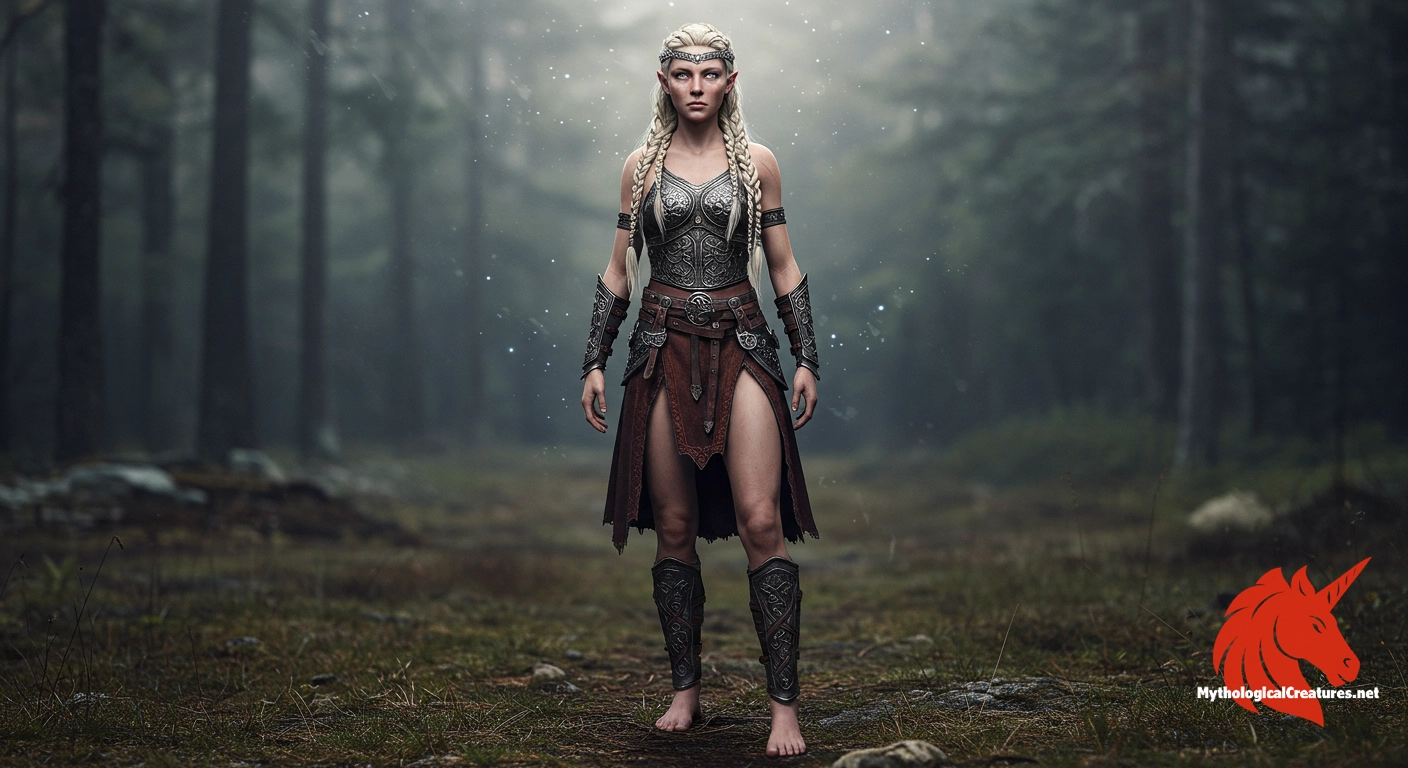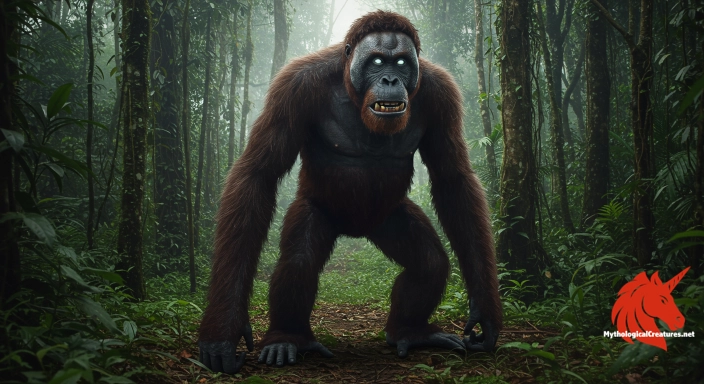Hervör alvitr: Hervör alvitr is a Norse valkyrie known for her wisdom and role in selecting the slain on battlefields.

Hervör alvitr
Hervör alvitr - Represents divine intervention in battle and the link between mortal valor and the afterlife.
Origins & First Encounters
Hervör alvitr emerges from the strands of Norse myth as an enigmatic valkyrie, whose very name hints at both wisdom and otherness. Born into a noble lineage as the daughter of King Hlödvér and the sister of Hlaðguðr svanhvít, she occupies a singular space within the ancient lore. Her name, often interpreted as 'all‐wise' or a 'strange creature', encapsulates the layered symbolism that surrounds her identity. She is vividly brought to life in the Poetic Edda’s poem Völundarkviða, where her familial ties and her seven‐year marriage to the legendary smith Völundr are laid out. This unusual marital union marks her story as one that bridges the ethereal aspects of the divine with the tangible realm of mortal craft. Her narrative interweaves themes of destiny, battle, and the transformative power of craft, elements that resonate deeply within Norse cosmology. The delicate balance between her martial duties and personal life has intrigued audiences since the earliest attestations of her legend. As a figure drawn from a rich oral tradition, her myth encapsulates the enduring Norse admiration for both intellectual acuity and combative prowess. Her tale, though presented in passing within the texts, invites ongoing exploration into the interplay between fate and wisdom. Over time, interpretations of her character have grown, reflecting the dynamic nature of myth as it adapts to changing cultural contexts.
Source Texts & Tale Variants
The primary attestation of Hervör alvitr can be found in the venerable verses of the Poetic Edda, specifically in the poem Völundarkviða, where she is introduced as a central yet enigmatic figure. Ancient manuscripts preserve her brief mention, ensuring that her connection to both divine lineage and heroic narratives endures. The text succinctly records her familial bond as the daughter of King Hlödvér and her role as the seven‐year wife of the master smith Völundr, providing a framework that has inspired later retellings. Over time, the brevity of her original appearance has given way to a range of interpretative expansions in oral and written traditions. Alternate story variants, though not as prolific as other myths, have enriched her character by emphasising her wisdom and the mysterious aura that surrounds her. These evolving narratives have allowed storytellers to blend historical memory with poetic embellishment in subtle yet enduring ways. Even minor poetic nuances observed in the medieval texts have opened avenues for further scholarly debate and reinterpretation. In a landscape where myth is malleable, Hervör alvitr’s portrayal has grown to encompass additional layers of narrative complexity. Fragmentary though the account may be, the intrinsic allure of her character has inspired diverse versions across the centuries. This intersection of sparse textual references and later folkloric elaboration reinforces the timeless quality of her myth.
Form & Powers
Artistic imaginings of Hervör alvitr render her as a figure of sublime beauty intertwined with the fierce bearing of a warrior. She is frequently depicted clad in gleaming, intricately wrought armour that seems to capture both the fire of battle and the soft glow of dawn. Her hair, often envisioned as flowing and dark with hints of starlight, frames a face imbued with both grace and resolute determination. Striking eyes, deep-set and luminous, are said to mirror the wisdom suggested by her very name, inviting those who gaze upon her to contemplate mysteries beyond the mortal realm. The delicate embellishments on her attire echo the ancient runic symbols that link her existence to the spiritual forces of the Norse cosmos. In some artistic traditions, ethereal wings or a faint, spectral outline are attributed to her, suggesting her role in escorting the souls of the fallen. Her physique is variably portrayed—from a slender, agile silhouette to a more robust, formidable presence—each reflecting the multifaceted nature of her character. The interplay of light and shadow in depictions of her accentuates both the softness of her features and the hardness of her warrior spirit. Every element, from the polished metal of her armour to the subtle glimmer in her eyes, is rendered to evoke a sense of divine mystique. Through these vivid details, the physical representation of Hervör alvitr evolves into a powerful symbol of the confluence of beauty, wisdom, and martial strength.
Regional Faces
Across the varied landscapes of Scandinavia, the legend of Hervör alvitr has been adapted to reflect regional cultural nuances and local storytelling traditions. In Iceland, where the oral tradition remains particularly robust, she is often portrayed as a mystical guide whose otherworldly presence enhances the stark beauty of the highlands. Swedish renditions sometimes blend her character with local heroic lore, emphasising a benevolent yet resolute aspect that speaks to regional ideals of strength and resilience. In Norway, local narratives have linked her persona with the dramatic interplay of natural elements, depicting her as a harbinger of fleeting mists or sudden lights along rugged fjords. These folk adaptations allow for subtle variations in her attire, symbolic artefacts, and even in the tone of her interactions with mortal realms. The fluid nature of regional myth-making has led to distinct portrayals that mirror local historical experiences and environmental influences. Some communities elevate her role to that of an ancestral protector, while others celebrate her as a symbol of sublime spiritual insight and martial vigour. This diversity in interpretation highlights the capacity of Norse myth to merge timeless themes with specific cultural contexts. Each regional variant enriches her story, creating a vibrant tapestry of interpretations that continues to evolve. The interplay between universal motifs and local tradition ensures that Hervör alvitr’s legacy remains as multifaceted as the lands from which her legend springs.
Cultural Parallels
A comparative glance reveals that Hervör alvitr shares compelling similarities with other mythological figures across the Indo-European spectrum. Her function as a guide to the fallen resonates with the broader archetype of divine warrior maidens, aligning her with figures such as the Germanic Brunnhilde and the Celtic embodiments of battle spirit. The duality of her nature—a blend of refined wisdom and formidable martial prowess—finds echoes in various cultural traditions where female figures bridge the mortal and the divine. Her narrative, marked by an intimate union with the mortal craftsman Völundr, also invites parallels with other mythic pairings that highlight the union of creativity and conflict. Unlike some counterparts whose stories focus solely on heroic sacrifice or vengeance, Hervör alvitr embodies a synthesis that underlines both the nurturing aspect of wisdom and the rigorous demands of combat. This intersection of roles is reminiscent of other legendary figures who are equally celebrated for their nurturing of fate as they are for their martial engagements. The enduring themes present in her myth—destiny, transformation, and transcendence—are seen throughout a myriad of cultural legends. Comparative analysis reveals that while every tradition channels these motifs in unique ways, the figure of the valkyrie retains a distinctive power that is both universal and uniquely Norse. In this light, Hervör alvitr stands as an engaging counterpoint to a range of warrior deities and heroic archetypes found in myths around the world. Her story ultimately underscores the shared human fascination with the forces that govern both battle and the mysteries beyond.
Legacy & Modern Evolution
The evolution of Hervör alvitr’s myth from sparse medieval references to a celebrated figure in modern reinterpretations reflects the dynamic nature of cultural storytelling. Early texts offered only brief glimpses of her character, situating her among a pantheon of valkyries whose duties were largely confined to the battlefield. Over time, however, her role has been reimagined in ways that underscore a deeper narrative richness, particularly regarding her union with the legendary smith Völundr. Modern adaptations often cast her as a symbolic bridge between the raw exigencies of combat and the sublime realms of wisdom and craft. Contemporary artists, writers, and even filmmakers have drawn on her enigmatic persona to explore themes of feminine empowerment, resilience, and the mystical interplay between destiny and decision. As academic interest in Norse mythology has grown, Hervör alvitr has come to be viewed as a figure of enduring relevance, whose myth offers insights into both ancient values and modern sensibilities. Her legacy is celebrated in a range of creative mediums—from graphic novels and paintings to stage productions—that recontextualise her narrative for new audiences. The gradual transformation in her portrayal reflects broader cultural shifts, where ancient symbols are revitalised to address contemporary concerns about identity and power. In this ongoing evolution, her myth stands as a testament to the timeless capacity of legend to inspire, challenge, and transform. The enduring appeal of Hervör alvitr thus lies in her ability to encapsulate both the martial spirit of the past and the imaginative possibilities of the present.
Interesting Fact
An intriguing aspect of Hervör alvitr is her transient marriage to Völundr, which reflects the complex interplay of fate, love, and duty in Norse myths.
Quick Creature Info
Origin:
Our Mythic Legendary Rating:

Habitat:
Supernatural Powers:
Physical Attributes:
Abilities:
Behavior:
Lore:
References
Discover Another Mythical Legend You May Not Have Heard Of?
Uncover the mysteries of ancient folklore and expand your knowledge of legendary beings from cultures around the world.
Dare to Meet the Orang Mawas....
Mythical Disclaimer: The images and data on this site are derived from various historical and literary sources, but we have found that many myths often have multiple versions and interpretations across references, sometimes contradictory. As a result, these creature depictions are artistic interpretations—imaginative blends of folklore, legend, and a dash of AI guesswork. Because creature descriptions vary widely, our illustrations and accompanying information represent our best effort to honor mythology while bridging creative gaps. Enjoy these interpretations—just remember, we've done our best to respect the stories and validate available data, but in the realm of mythology, details often shift, imagination leads the way, and nothing is ever set in stone!
Curated by the Mythological Creatures Team (rev. May 2025)
